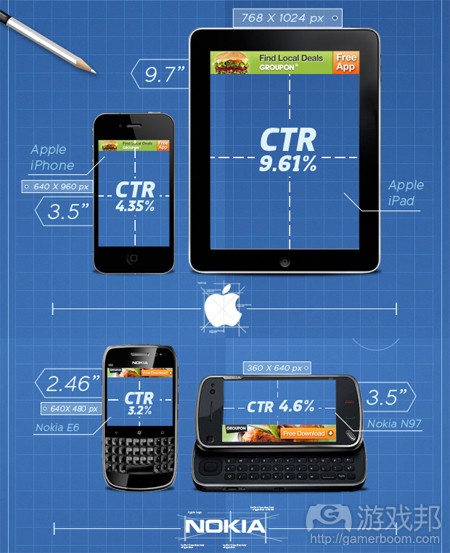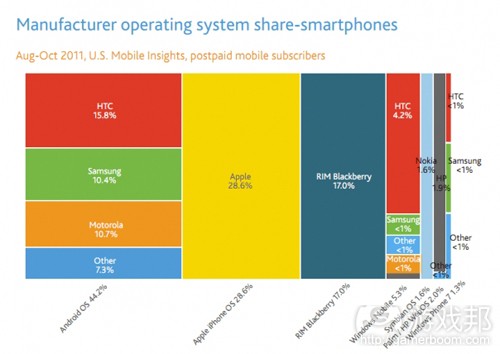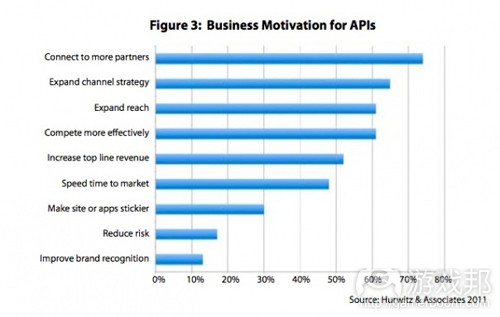每日观察:关注Rovio或于2013年在香港上市(12.17)
1)据路透社报道,芬兰开发商Rovio或将于2013年在香港进行IPO。
该公司首席营销官Peter Vesterbacka曾透露Rovio的目标是成为身价堪比迪士尼的企业,并预计公司2011财年的营收将达1亿美元,远超上一年的1000万美元。
Rovio曾在今年表示计划于未来五年在美国上市,原因是其游戏玩家多集中于美国,但路透社报道并未指出Rovio本次为何改变了计划。
2)NPD Group旗下的Connected Intelligence曾发布报告指出,在2011年4月,60%的平均电脑用户仅使用家里的无线网络,仅有5%受访者表示有意在未来6个月中使用3G网络服务。
而最近调查数据则表明,Wi-Fi网络仍居主导地位,在平板电脑用户中的使用率增长至65%。
Connected Intelligence认为移动网络流量费用是人们较少使用3G服务的一大原因,此外,Wi-Fi网络在多数地点的普及和便捷性,也是其使用增长率的重要原因。
3)咨询网站SigFig最针针对30万用户的调查显示,iPhone用户对苹果品牌的忠诚度最高,16%的iPhone用户同时持有苹果股票,仅有8%的Android用户及6%的黑莓用户持有苹果股票。
仅有4%的Android用户持有谷歌股票,1%的Android用户持有摩托罗拉股票(由于Android操作系统持有者是谷歌公司,而Andorid移动设备制造商却包括摩托罗拉、LG和三星等多家公司,因此很难从中判断Android用户对其手机品牌的忠诚度)。
从总体上看,多数智能手机用户向苹果而非谷歌投资,而持有RIM股票的黑莓用户比例甚至不足1%。
4)据移动广告平台inneractive最新数据显示,广告点击率(CTR)与设备屏幕大小直接相关,设备屏幕面积越大,CTR就越高。该平台显示在应用商店GetJar的iOS应用中,iPhone应用的CTR为4.35%,而iPad则是9.61%。
7英寸三星Galaxy Tab设备上的CTR为9.23%,3.7英寸摩托罗拉Droid的CTR则是2.07%;诺基亚3.5英寸的N97移动设备的CTR为4.6%,2.46英寸的E6则是3.2%。
inneractive指出,宽大的移动设备屏幕更有利于有效展示广告,平板电脑应用程序比较有利于显示传统媒体内容,而且更有利于用户与广告进行互动。
5)尼尔森最新报告显示,美国智能手机用户已从2009年的18%增长至2011年的44%,其中半数以上属于18-34岁的用户群体(游戏邦注:尼尔森这项调查的受访者超过30万)。
苹果仍是美国头号移动设备供应商,iPhne用户在智能手机市场中占比28.6%,黑莓占比15.8%,HTC也是15.8%;在2011年8月至10月份,Android操作系统在所有美国智能手机用户中占比44.2%。
报告还指出,Android和iOS智能手机在过去30天中占据了83%的应用下载量,每名用户的移动设备上平均安装了33款应用,比2010年同期增长了22%。
iPhone用户是最活跃的用户,平均每人下载了44款应用,而Android用户的这一数据为32款应用。
49%的Android用户曾在过去一个月中下载应用,而2009年同期的这一数据仅为4%。
曾在上月下载应用的iOS用户比例则是34%,黑莓是11%,Windows Phone仅有3%。
搜索和口碑传播已经成为应用实现曝光度的主要渠道,27%受访者表示自己的孩子曾下载手机应用,还有13%受访者自称受到同伴影响才下载了某些手机应用。
6)科技调研公司Hurwitz & Associates最新报告表明,在网站服务中添加一个优秀的API,可以推动网站增加70%的流量。
该报告调查了24家公司的API使用情况及原因(如下图),并发现除了推动网站流量增长,添加API还可以提高获取客户的效率,减少30%建立合作伙伴关系的时间。
7)据insidemobileapps报道,谷歌最近发布一个Android Training网站,旨在指导新手针对Android平台开发内容。
该网站提供了面向多种屏幕大小的设备开发内容的课程,并提供了实例进行说明。例如,用户电池电量较低时,最好让Android应用改变自己的状态进入省电模式(如下图)。此外其课程还示范了一些根据屏幕大小更改应用布局的技巧(这一点对面临严重的平台分裂问题的Android来说尤为重要)。
其课程划分为不同类型,例如“企业开发课程”(主要锁定开发商务应用的群体)、“应用盈利方法”等。(本文为游戏邦/gamerboom.com编译,拒绝任何不保留版权的转载,如需转载请联系:游戏邦)
1)Report: Rovio Looking To List Hong Kong IPO In 2013
by Mike Rose
Angry Birds developer Rovio is looking to list an initial public offering on the Hong Kong stock exchange sometime in 2013, according to media reports.
Angry Birds is one of the most successful video game franchises ever created, with over 500 million downloads across all its versions and platforms as of last month.
Speaking to Finnish weekly magazine Tekniikka&Talous, and as reported by Reuters, Rovio’s marketing chief Peter Vesterbacka revealed that the company is looking to grow into a media firm with a market capitalization around the same as that of Walt Disney Co, which has a share value of $65.3 billion.
“That is the target. There is no reason why we should not be able to build a company of that size,” he suggested.
He also revealed that Rovio should see revenues of $100 million for the 2011 fiscal year, up significantly from revenues of $10 million in the previous year.
Rovio had already said previously this year that it was looking to make an initial public stock offering sometime in the next five years in the U.S., noting that “our fans are primarily in the U.S., so it’s easy for us to bring our brand there.”
This new report did not note why the company has changed its mind, and now wants to list via on Hong Kong stock exchange instead.(source:gamasutra)
2)Wi-fi dominates tablet connectivity
by Tim Green
Survey says 65 per cent of US users are wi-fi only.
The NPD Group’s Connected Intelligence report revealed that in April 2011, 60 per cent of tablet users only connected via wireless in the home, and that just five per cent said they planned to get a 3G connection within the next six months.
But six months on, wi-fi has cemented its dominance, and grown to 65 per cent of tablet users.
NPD reckons a combination of cost, public wi-fi and tablets that don’t do 3G are conspiring to bring about the dominance of wi-fi.
Eddie Hold, vice president of Connected Intelligence, said: “Concern over the high cost of cellular data plans is certainly an issue, but more consumers are finding that wi-fi is available in the majority of locations where they use their tablets, providing them ‘good enough’ connectivity.
“In addition, the vast majority of tablet users already own a smartphone, which fulfills the ‘must have’ connectivity need.”
He added that if the 3G rate is low now, with the early adopters, it will be a challenge to increase it when the more cost-conscious mainstream gets the tablet habit.(source:mobile-ent)
3)iPhone owners likely to invest in Apple, but not even Blackberry users want RIM stock
Sarah Mitroff
You may love your phone, but do you love it enough to invest in the company that makes it? Well, if you own an iPhone you are more likely to also own Apple stock, a recent survey reveals.
SigFig, an investment tracking and advice website, conducted a survey of its 300,000 members to find out how loyal mobile customers are to the brand behind their phone. The results show that 16 percent of iPhone owners also own stock in Apple, compared to just over 12 percent of all SigFig members. In addition, only eight percent of Android owners and six percent of BlackBerry owners have stock in Apple.
Apple by far has the highest loyalty of smartphone owners among the survey respondents, a trend not seen with those who use Android or Blackberry phones. Only four percent of Android owners have stock in Google, and even fewer — less than one percent — own stock in Motorola. Loyalty to Android is harder to show because you can either own stock in the company that makes the software (Google) or one of the many the manufacturers of Android hardware (Motorola, LG, Samsung, etc). Still, far more smartphone users are investing in Apple than Google.
Blackberry fairs the worst; less than one in 100 Blackberry owners have stock in RIM. That’s right, even people who willingly own and use Blackberrys won’t invest in RIM.(source:venturebeat)
4)Mobile ad click-through rates on tablets double to over 9%, reports inneractive
by Keith Andrew
It’s generally understood device screen size can have a major impact on game design, but the latest infographic released by ad platform inneractive also suggests it has a role to play when it comes to advertising.
According to the firm’s numbers – published by app store GetJar – in the case of iOS, click-through rates (CTR) jump from 4.35 percent on iPhone to 9.61 percent on iPad.
It’s a trend that extends across operating systems: Samsung’s 7-inch Galaxy Tab, for instance, generates a CTR of 9.23 percent to the Motorola Droid’s 2.07 percent on its 3.7-inch screen.
Bigger equals better
“Essentially, the larger a screen size a device has, the higher the click-through rate becomes,” summarises GetJar.
“It’s not hard to imagine that with more screen real estate, ads can become larger and harder to miss. Also, tablet apps can better convey traditional media formats where users are more use to seeing and interacting with advertisements.”
Apple’s tablet is the most prevalent of all the platforms analysed according to inneractive’s numbers, but even advertising on a touchscreen smartphone compared to one equipped with a keyboard can prove more fruitful.
Nokia’s 3.5-inch N97 enjoys a CTR of 4.6 percent. That compares favourably to the 2.46-inch E6, which has a CTR of 3.2 percent.(source:pocketgamer)
5)iPhone 4 led U.S. smartphone gains in 2011
By Darrell Etherington
Apple’s iPhone 4 was the leading mobile phone in the U.S., despite being a phone launched mid-way through 2010, according to a new Nielsen report. The iPhone helped propel smartphone usage in the U.S. to new heights during the past year.
Smartphone penetration rose significantly compared to two years ago, Nielsen noted. In 2009, just 18 percent of mobile phone users were packing smart devices, while in 2011, that number had risen to 44 percent of U.S. residents, with more than half of adults between 18 and 34 counted among them. The iPhone in general has done a lot to propel that adoption.
Of individual device vendors, Apple is still very much on top, despite the fact that Android as a platform has eclipsed its market share on devices. Apple’s iPhones account for 28.6 percent of all postpaid smartphone subscribers, compared to 15.8 percent for BlackBerry, the next closest competitor, and 15.8 percent for HTC, the Android handset-maker with the largest manufacturer share. All together, Android devices accounted for 44.2 percent of U.S. postpaid plans between August and October 2011.
Nielsen takes its results from monthly surveys of more than 300,000 consumers, as well as data from devices belonging to users who opted into market research and data from phone bills from 65,000 volunteers.(source:gigaom)
62 per cent of Americans have downloaded mobile apps
by Zen Terrelonge
Average of 33 apps on each user’s smartphone.
Research firm Nielsen says Android and iOS smartphones were behind 83 per cent of the downloads, which came over a period of 30-day period.
The average of 33 apps on each downloader’s device, is up 22 per cent from the same time in 2010, according to the report.
Results show that iPhone apps downloaders were the most active with an average of 44 apps, while Android downloaders created an average of 32 apps.
Android app activity has bloomed though. The report says 49 per cent of all Android device owners downloaded an app across the last month, which is up from four per cent in 2009.
This beats iOS that had 34 per cent of users downloading an app in the last month, in addition to BlackBerry users on 11 per cent and Windows Phone users on three per cent.
App discovery seems to be driven by searching and word of mouth. 27 per cent say that their children downloaded apps to their phones, while partners are responsible for 13 per cent of apps on the other’s handset.(source:mobile-ent)
6)Hey devs, APIs are good for you.
By Stacey Higginbotham
Adding a good API to your web service can result in a 70-percent increase in traffic, according to a survey out this week from a tech research firm. The survey, conducted by Hurwitz and Associates, also laid out the business and technical reasons for introducing an application programming interface, otherwise known as an easy way to integrate a service into a third-party site. Unsurprisingly, the top of both lists involved a business’ relationship with its partners.
More than anything, APIs are the star of the current social web scene. Whether it’s a social app sharing information across “clouds” or a way to bridge multiple platforms with a bit more ease, having an open API is key to providing an app or web service today. Clearly, companies know this. The Hurwitz survey talked to 24 companies using APIs to discover why they were doing so and what the results were.
In addition to the increase in web traffic, there was a 30-percent decrease in the amount of time required to get a partnership relationship running smoothly. I have no idea how this is actually measured, but respondents also said they had a 30 percent increase in the ability to bring new ideas to market quickly. More than the broad conclusion that APIs are good, we can look at them as a much-needed way to automate processes that might have once taken weeks of planning and contract negotiations to map out.(source:gigaom)
7)Google’s New Android Training Site Offers App Design Advice and Tutorials
Todd Ogasawara
As data this week hinted that Apple is paradoxically gaining on Android among developers starting new apps, Google launched a new Android Training site for to help newbies this week.
The site provides classes to help developers figure out basic issues like designing for multiple screen sizes. Each is made up of a few lessons.
They try to push best practices like: if a user’s battery runs low, an Android app can should be able to change its state to preserve its charge. The classes also show different tricks that developers can use to alter the layout of their apps for devices with different screen sizes — which is important because of Android’s overwhelming issues with fragmentation.
There are a couple specialty classes as well. Developing for Enterprise has a single lesson about Enhancing Security with Device Management Policies. While RIM’s Blackberry platform has long had a core audience in the enterprise segment, Apple and now Google are eyeing corporate customers. The sections covers topics like declaring a policy, adding a device administrator and policy controller (who would control access to the phone’s sensitive data), and dealing with policy differences in various Android OS releases. An example is the Password Minimum Upper Case policy which is only available starting with Android OS 3.0 Honeycomb (API level 11). The Monetizing Your App‘s single lesson is about Advertising without Compromising User Experience. It provides examples of how to use banner ads without frustrating consumers.
The Google Training site offers other technical resources like sample code and articles on problems such as avoiding memory leaks and tutorials — including the ubiquitous “Hello, World.”(source:insidemobileapps)














































 闽公网安备35020302001549号
闽公网安备35020302001549号